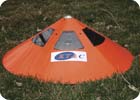Storm Chasers

On June 11 2005, a National Geographic research team did the near impossible: they chased down a tornado and placed a probe with KPC-650CH video cameras from KT&C, Los Angeles, directly in its path. Beginning at precisely 2:23 p.m. the team caught images that made it possible to calculate wind speeds close to the ground, where tornadoes rip through human lives.
Even after his team found the tornado and drove along a dirt road in Iowa to a place they were fairly certain lay in its path, the team remained unsure of where exactly to leave the probe. At the last second, the 80-pound probe was repositioned 40 feet to the north from its original position. The eye of the tornado passed just 10 feet from the probe, giving the cameras the closest every view of the fierce winds turning just off the ground around a tornado’s center.
Scientists can measure wind speeds with mobile Doppler radar, but only from a safe distance. The cameras looked into a part of the tornado long hidden from scientists using Doppler: the bottom 30 feet. Winds at this level flatten houses and hurl cars. Understanding these winds – the tornado’s strongest and most erratic – may enable engineers to design better tornado – resistant structures.
Looking for a reprint of this article?
From high-res PDFs to custom plaques, order your copy today!


